La Ciudad Y Los Perros - The Time Of The Hero
Saturday, September 30, 2006
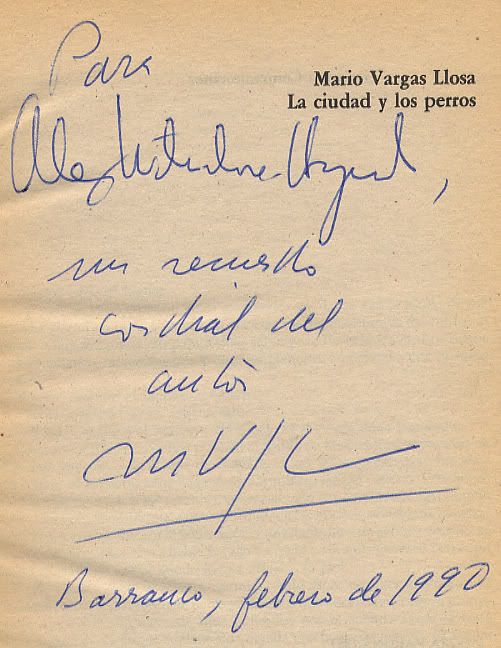  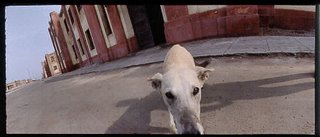 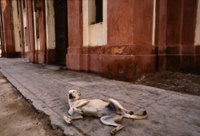 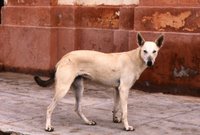 Mario Vargas Llosa's first novel, published in 1962, La Ciudad y los Perros, translates as the City and the Dogs but its 1966 translation into English became the more romantic The Time of the Hero. The novel is an autobiographic account of Vargas Llosa's stay as a young boarder in the Leoncio Prado Military Academy in Callao (Lima's port). This novel was so critical of the military academy that the Peruvian military burned 1000 copies of it when it was published. But in 1990, When I went to Peru to interview and photograph the author, who was running for the presidency, his name was sufficient to get me into any building, school or institution mentioned in any of his essays and novels. By 1990 I had managed to read all of Llosa's output to that date and I had been particularly affected by a short story, Los Cachorros or The Cubs with disturbing happenings in a private school. A young man loses his private parts to a dog that attacks him in the shower. How this young man grows up in a Latin American macho society is the fascination of this short story that was later made into a movie in Mexico. So when I arrived at the Leoncio Prado Military Academy I was almost shocked by the dog that greeted me at the entrance. It was the South American summer vacation so the school was empty and eerily quiet, except for a whistle from the almost constant wind from the Pacific, a few yards away. I photographed the almost elegant dog and went through the school which was exactly as described in the book. The bunk beds were there as were the empty lockers. When I told Vargas Llosa about my visit I first realized that curious reticence by novelists to acknowledge or admit that any place (even when named) in one of their novels could actually exist. When I located the famous ice cream store central to the plot of La Historia de Mayta (1984), English translation (1986)The Real Life of Alejandro Mayta, the man was visibly anoyed. Mario Vargas Llosa
Of Daturas, Brugmansias and Floripondios
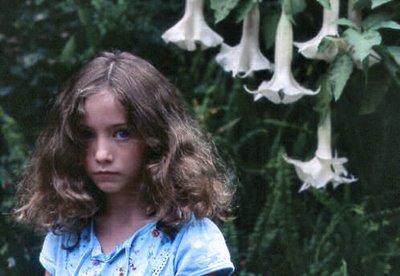
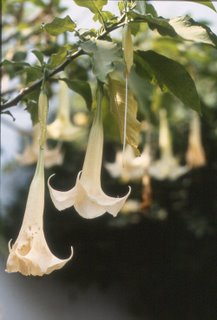
There is much confusion on these two closely related plants, the Datura and the Brugmansia. It's simpler to think about it in Spanish. In February, 2000 I was in Mario Vargas Llosa's garden in Barranco, a neighbourhood of Lima, Peru. I had never seen this little tree in my life (right, the floripondio in Vargas Llosa's garden). I asked Vargas Llosa for its name. "Es un floripondio," he told me. The plant is from the tomato family and it is supposed to be either deadly or halucenogenic, or both. That a young man died in the BC interior after ingesting (he wandered quite confused for a while)a native BC datura might confirm that indeed it is deadly.
A various times of the day and particularly during warm and humid nights the several floripondios that grew in our Morelia hotel last August spread the sweetest perfume imaginable. I photographed Rebecca by one which was a double form in Morelia, Michoacán, Mexico.
Floripondios
The Salesian Nuns & The Priest
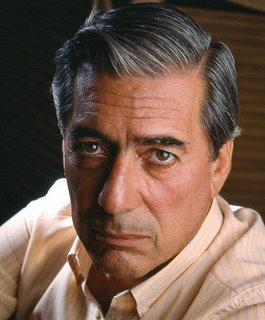 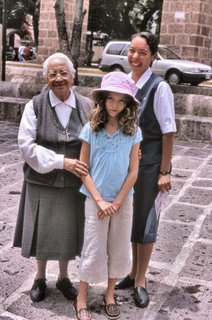 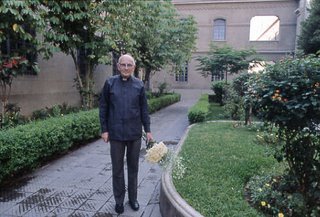 We were sitting on a stone bench by the imposing aqueduct in Morelia, Michoacán in Mexico last August, when these two nuns passed by. To see a nun almost dressed like a nun in Mexico is a treat since in the 60s and before, nuns, brothers and priests could not wear anything but civilian attire on the streets. I stopped them and asked them from what order they were. They told me they were from the Salesians, originally from Italy. They posed with Rebecca and I asked the older nun to bless her. As they walked away I remembered a Salesian priest I had photographed back in 1990 in La Escuela de los Salesianos, a Catholic school in Lima where Mario Vargas Llosa had gone as a young boy. I had asked Padre Francisco if he could tell me anything about the novelist who was soon to be president. He was very diplomatic and unforthcoming, "He was a good boy." He turned around and walked away with his bunch of flowers. The soon-to-be president wasn't. One morning , the morning he returned from campaigning in Piura, he was very sick. Piura is a city in Northern Peru which was the first city in Peru, founded by Francisco Pizarro in 1532. Llosa had eaten a ceviche that had given him stomach poisoning. He was in pain when he posed for me. That evening he was to give a talk at the Japanese Peruvian Club. I went to it but he stayed home. The Japanese/Peruvian community felt ignored. The rest is history as Fujimori came from nowhere and won the election. For those of us who love his books this has meant that Vargas Llosas literary output was never interrupted. For me Vargas Llosa's loss was a bittersweet experience. I love his books but I will never know what would have happened if Condé Nast Traveller had published my essay and photographs, Mario Vargas Llosa's Lima. It all hinged, the travel editor told me, "If he wins."
ultra-brite Mexico - Hawaii
Friday, September 29, 2006
   It was over 35 years ago that I was teaching English to Colgate Palmolive executives in Mexico City. We were discussing our perception of colour. This bunch spoke quite well and many of them were from the marketing department. It had all started when one of my students raised the subject of what could be wrong with the marketing of ultra-brite their latest tootpaste at the time. I really liked it. Somehow Colgate Palmolive had circumvented the Mexican health regulations and this product had ether. When you brushed your teeth if felt like you had foaming and tingling ice water in your mouth. I loved it. But I had my suspicions on why Mexicans avoided buying it. I asked my class how they liked the combination of dark blue, gray and white as compared to red, orange, pink, yellow and white. The class agreed that the former cool colour combination was not to their liking. I then pointed out that the cool colours were those of the ultra-brite boxes while the others of the competing and better selling Crest. While globalization is now helping (or hindering) the personal colour tastes of nations we came to the conclusion then in that Colgate Palmolive class that Mexicans liked hot reds while nations further away from the equator tended to like cooler colours like blues and greens. At the time Mexico City traffic was a Technicolor display of red and yellow. The green mountains of the rainy season changed to rich browns and ochres in the winter. The colour of the light in Mexico City (filtered by pollution) was warm. People in the street wore bright coloured clothing. Vendors sold sliced oranges or corn on the cob with liberal sprinkling of red chili powder. In Vancouver, by early August when I look at the North Shore Mountains I can already see the cyan in the blue of the sky. Cyan is a cold colour. To me it is our "winter blue". It depresses me. By November Vancouver is green, blue and gray. By January, those who can, go to Hawaii. Those of us that can't, make do with Art Bergman's ultimate Vancouver song, Hawaii: Let's go to fucking Hawaii
Get down in the sun
I want to lay on Wakiki
Get a tan on my bun
Running from the rain, thousands on the run.Perhaps I have lived too long in Vancouver and I have lost my memory for the hot colours of Mexico. This August I spent hours shooting blue agaves in Michoacán, Mexico. I miss my ultra-brite and those reds, those ochres....
Horseless Carriages & Digital Wonders
Thursday, September 28, 2006
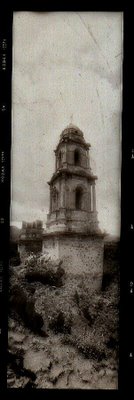 Not too long ago I got into one of those senseless arguments about film versus digital. These arguments are no different from religious or political ones. None of the participants will give ground and the argument will end in shouts, flaming and insults. But this time I was into something. The guy on the digital end said my scans of my original transparencies (large slides) and negatives were poor imitations of the real thing. I thought about "the real thing". I got back to him by saying that in reference to my slides and negatives, I could burn them, twist them, project them, print them, even ignore them in a shoe box and if I wanted to I could even chew on them. "Where is your original? Is it a series of 1s and 0s inside a memory card? Can you touch and chew those 1s and 0s?" The guy on the digital end had no way of refuting this and the argument ended in my "victory". Photography is in a hard to predict transition. Those who shoot digital are out to prove how their digital cameras can mimic film and print large images and ask you to guess if they are digital or photographic prints. This is senseless. What would you think of a person driving a horseless carriage that could deposit stuff on the street every few blocks that looked just like horse droppings? What would we think if the horseless carriage were to spray your own vehicle with a steaming yellow liquid? Digital photographers must look into the future for indication of where they are going and should leave us, who shoot film, in our past. Of that past Roland Barthes wrote eloquently in his Camera Lucida - Reflections on Photography:One day, quite some time ago, I happened on a photograph of Napoleon's younger brother, Jerome, taken in 1852. And I realized then, with an amazement I have not been able to lessen since: "I am looking into the eyes that looked at the Emperor." Sometimes I would mention this amazement, but since no one seemed to share it, nor even to understand it ( life consists of these little touches of solitude), I forgot about it.That photographic past can sometimes crop up into our present. I took my Dresden made Noblex 175 to our Morelia, Michoacán, Mexico vacation in August. The camera, which has a swiveling wide angle lens, takes a picture that is 50mm by 175mm. The b+w negatives I took were too big for the 4x5 inch limitation of my scanner's negative/slide lightbox. I decided to place the negatives right on the scanner bed and placed a sheet of white paper on top. I scanned it and got a negative image. When I reversed the image (with Photoshop) the result was earie. It looked like a William Henry Fox Talbot, "Talbotype". These (taken in the 1840s) were paper prints made from paper negatives that were sandwiched on to sensitized paper to make a positive. Here you see the partially buried church of San Juan Parangaricutiro not too far from the Paricutin volcano that first erupted in 1943.
Doug Holtby - Broadcasting in the Bathroom
Wednesday, September 27, 2006
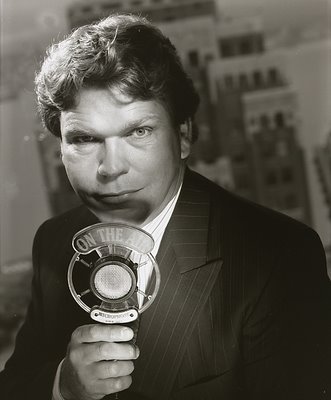 On Monday afternoon I went to Baseline Type and Graphics to okay the proof on my new busines card. I needed new ones to incorporate this web page and blog address. While walking on Robson I noticed a tall man with glasses outside the Telus building. It was 2:55 and he was leaning on a Georgia Straight dispenser. I went up to him and said, "You are Doug Holtby." He looked at me and said, "You have a long memory. Sometimes I am not sure myself if I am Doug Holtby." We chatted and I asked him why he was there. It seems that he is a consultant. Holtby, the former CEO of WIC West is an expert in broadcasting. Telus is trying to get into the game of bringing TV into our homes through a phone cable and even with wireless technology. Soon we will be able to watch that game on our cellular while being where even the king is alone. Holtby asked me for my card! And of course I don't have any yet. At home I checked my files and this photo of the man I took in August 1990.
Las Serias - The Serious Ones
Tuesday, September 26, 2006
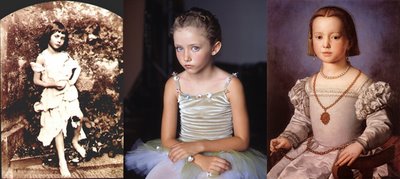 For a year I photographed my granddaughter Rebecca looking at the camera. I never asked her to smile. She never volunteered and that was fine with me. Rosemary (my wife) was troubled until I explained to her that perhaps Rebecca wanted to act like an adult or was simply giving me the face she thought was "adult" like. In this series you can see a photo of Alice Liddell on the left, taken by the Reverend Charles Dodgson. I believe that Dodgson, as Lewis Carroll, may have written his Alice books as a gift to a young girl that he saw as an adult. Perhaps in the 20th or 21st century Carroll would have been locked up. Much has been written how in Victorian England children were exploited in the workplace. They were seen as small adults. The photo in the centre is of Rebecca with her "adult" face. On the right is Bronzino's (1503-1572) portrait of Isabella de'Medici. Today I had a little chat with Rebecca. I tried not to weigh her forever, as my mother did, when she told me, "Alex you have many flaws but you have one redeeming quality. You have integrity." I believe that I may even ask Rosemary ( if I don't suddenly die in a vaporizing explosion which would make it all so much easier!) that she inscribe on my tombstone, "He died with integrity." My mother's pronouncement has been a lead weight around my neck. I told Rebecca that as lovely and talented as she might be she has one quality above all others. It is her ability to respond to logic. She is reasonable in the real sense of the meaning of that word. I asked her what was the possibility (we were driving in Sophie, Rosemary's car) that a meteorite might hit Sophie's roof and kills us on the way to Nikolai Maloff's piano lesson. Rebecca answered that it was possible but unlikely. I then told her that the study of the process of probability is called statistics. She then made that leap that surprised me, but somehow I statistically expected. She said, "This means that if I quit my piano today, I might start it up again later but statistically it is unlikely that I will." I wanted to scream, "Eureka," but I didn't.
Ayesha
Monday, September 25, 2006
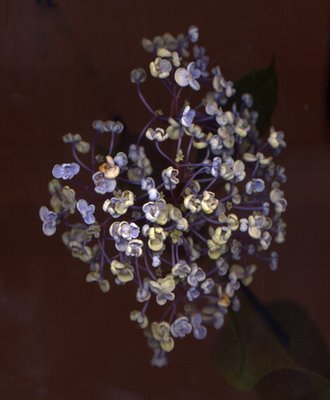 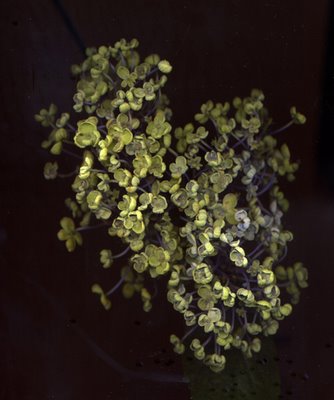 We are expected to notice and glorify the young and the perfect. We lust after shiny new cars - Porsche Boxters and try to prolong it all with Botox. Our wooden floors have been Varathaned to perfection. The idea of using special slippers (so as to not mark the old floor) when we visited Iolani Palace, the official residence of King Kalakaua and Queen Liliuokalani, in Honolulu, seems quaint now to me as I look into my garden and compare two separate mopheads from the same bush of my Hydrangea macrophylla 'Ayesha'. This mophead is so different from the others (I have over 35 varieties of hydrangea and 6 species) that I can agree with many who want to place this delicate plant in a separate species. The Ayesha, above left is a younger flower while the other bloomed earlier in the season and it is going green. What makes hydrangeas so beautiful is the transformation from youth to old age. A human lifetime in one season is there for me to observe and enjoy. When I look at the old photographs of Rosemary and me from 40 years ago now, my nostalgia is modified by my understanding that beauty, like a hydrangea inflorescence, lasts much longer than I used to think.
Notes Of Compassion
Sunday, September 24, 2006
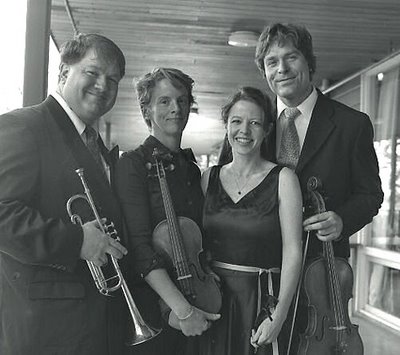 When I looked at my program of Notes of Compassion ( a volunteer collective of musicians from the VSO who played, without a conductor, yesterday as a benefit for Health Arts Society at Vancouver's George Pearson Centre), I knew I was going to need some Kleenex. After all there was Claude Debussy's Clair de Lune smack in the middle of the program! As I watched the over 200 concert goers, some on wheelchairs and with respirators, I noticed their smiles and I cried. But I wasn't prepared to cry twice and this is what I did when I listened to Kurt Attenberg's (worked for the Swedish patent office a job description that he shared with Albert Einstein who held the same job in Bern) Suite for Violin, Viola, and Strings, Op.19, No1. The violist, Andrew Brown explained how this suite inspired him as a young man to become a musician. The suite was lovely. Before the "crying pieces" I was jolted into attention by Frederick Shipizky's Aurora Fanfare which featured the VSO Brass Quintet. The wake up call that this was was followed by a spirited (as in nice and quick which is how I like it) performance of Bach's Brandenburg Concerto No. 3 in G Major. Notes of Compassion also played a very loud (that's how I like it!) couple of Dvorak's Slavonic Dances (Op. 46, No.s 1 and 8) and Haydn's Trumpet Concerto in E Flat Major. It was the Haydn Concerto that made me think that the first time I had ever heard it live was with a conductor (a not yet Sir, Eliot Gardiner) and trumpet player Martin Berinbaum at the Orpheum with the CBC Vancouver Orchestra (as it was called then) perhaps in 1982 as my original program has no date. The version I heard yesterday featured a very warm but confident Larry Knopp. The folks at CBC Radio have a fondness for jolting me out of bed at 6:30 with this concerto. But mid afternoon it was perfect. I wonder what violinist Karen Gerbrecht( seen here with Larry Knopp, left, Rebecca Whitling violin, and Andrew Brown, right, viola) might have thought of Knopp's performance as her father Jerold Gerbrecht was the principal trumpet player for the VSO for many years. If it had not been for a timely communication from Rebecca Whitling, my non readhead ( Karen is a redhead!) favourite VSO violinist I would have never known about the concert. A resident "spy" of the George Pearson Centre, and friend of mine, Maxine told me that the whole concert came together thanks to the persuasive influence of David Lemon who made a very short introductory speech. I noticed that Christopher Gaze was there and suddenly the perfect concert became a 99% one. Perfection would have been his interpretation (I have heard Gaze say it many times and I hope to hear it many more times!) of the St Crispin Day's Speech from William Shakespeare's Henry V. When I left for home there was one line from that speech that resonated in my head: We few, we happy few, we band of brothers;Somehow all who attended that concert could repeat those lines.
|

























